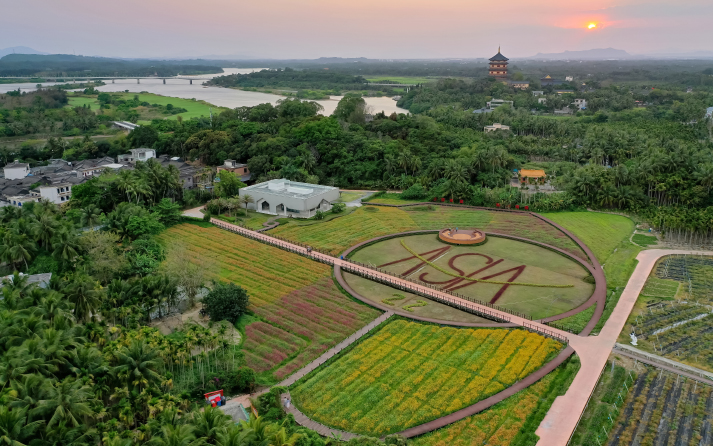| Voice |
| Bearing witness to Boao | |
|
|
 Aerial photo captures the lush green landscape of a village in Boao, a coastal town in Hainan Province and host of the Boao Forum for Asia Annual Conference since 2001, on March 24 (XINHUA)
The Boao Forum for Asia (BFA) convened its annual conference entirely offline in Boao, a coastal town in China's southern island province of Hainan, on March 28-31. Wang Sheng, President of the National Institute for South China Sea Studies (NISCSS) in Hainan, participated in creating the BFA in 2001 and has since been part of its many activities. In an exclusive interview with An Xinzhu, a reporter with the China International Communications Group Center for the Americas (CICG Americas), Wang shared his experiences with the BFA as well as his views on Hainan's development. Edited excerpts from their conversation follow: CICG Americas: The BFA is Hainan's international calling card. You have witnessed every stage of its growth. How would you comment on its evolving role and achievements since its establishment? Wang Sheng: The BFA is a good China story and I am just one of the people in it. I have been participating in the forum's development ever since its inception in 2001. I have seen it sprout from nothing and grow bigger and bigger. The BFA is now hailed as the Asian Davos, which speaks volumes about its international influence. (Davos, Switzerland, is where the World Economic Forum holds its annual meeting.) But different from the Davos forum, the BFA boasts strong regional characteristics, aiming to strengthen exchange and cooperation among Asian countries and between Asia and other parts of the world. With more than two decades of development, it has played an irreplaceable role in facilitating dialogue and cooperation among participating countries, building consensus and bringing prosperity to Asia. Many foreign media outlets and scholars consider the BFA an important platform to advocate Asian ideas, given it has provided the Boao approach to address economic issues facing Asia as well as the economic recovery of the continent and the world at large. The past years have also seen the forum take up an important role in promoting cooperation under the framework of the China-proposed Belt and Road Initiative, which aims to boost connectivity along and beyond the ancient Silk Road routes. It has also become a window for China to demonstrate its ideas of opening up and building a community with a shared future for humanity. As the birthplace of the BFA, Hainan has benefited from the forum. In your opinion, how does the BFA contribute to Hainan's opening up? Over the past 20-plus years, the BFA has become a signature brand for Hainan's opening up, which has contributed to the expansion of international exchanges and enhanced its international popularity. In turn, the province has also contributed its strengths to the BFA's development; both are interdependent and growing together. China considers Hainan a new engine of its high-quality development and the province's transformation into a free trade port (FTP) demonstrates the country's determination to push ahead with its high-level opening up. But what are the priorities of Hainan as an FTP? The island will become the world's largest FTP by 2035. This is a strategic decision of the Chinese Government based on all-inclusive considerations. This port is going to signify the highest level of opening up. There is no reference framework for building an FTP with Chinese characteristics, meaning Hainan not only needs to learn about advanced FTP construction from its global counterparts but also has to modernize its related systems on its own. With powerful policy support, the Hainan FTP has great potential to further develop the province's maritime economy, as well as its healthcare, big data, artificial intelligence and financial sectors. Hainan's sound business environment attracts both domestic and overseas investors. Located in the South China Sea, the province serves as the southern gateway for China's trade with Southeast Asian nations. It can combine the preferential policies of the Regional Comprehensive Economic Partnership (RCEP) with those of an FTP and make full use of the benefits. (The RCEP is a free trade agreement between the Association of Southeast Asian Nations (ASEAN) plus Australia, China, Japan, the Republic of Korea and New Zealand—making it the largest free trade bloc in history.) The province also needs to further refer to high-standard international economic and trade rules while formulating the industrial standards and regulations for the FTP.  Jewelry for sale at the Haikou International Duty Free City Shopping Complex, the world's largest duty free shop, in Haikou, Hainan Province, on December 17, 2022 (XINHUA)
Opening up and international cooperation are the essence driving Hainan's development. What are the province's advantages and what are the drawbacks it has to overcome? Chinese President Xi Jinping called for accelerating the transformation of Hainan into an FTP with Chinese characteristics and global influence during his inspection tour of Hainan last year. He added that Hainan will become "a paradigm of reform and opening up in the new era." With international exchange platforms such as the BFA and China International Consumer Products Expo, Hainan offers unique advantages in the field of global cooperation. But these platforms have also played a crucial role in local development. With both platform and policy advantages, Hainan has a brilliant future for institutional innovation. However, we still face an acute shortage of high-caliber professionals able to meet the requirements of FTP development. And so, governments at all levels are encouraging such professionals to participate in the building of the port. How should Hainan leverage its policy and geographical strengths in economic cooperation? We have put forward the concept of a "four-hour flight zone," meaning travelers from Hainan can arrive in almost all ASEAN countries, and some East Asian countries, within four hours. The province's ties with partners should feature "hard," "soft" and "heart" connectivity." "Hard connectivity" refers to the air and shipping routes. We should further expand these routes to connect with surrounding regions. "Soft connectivity" refers to exchanges and cooperation with FTPs within the four-hour flight zone. The island has a population of roughly 10 million residents, but there are 4 million overseas Chinese who hail from Hainan. So, as the hometown of many overseas Chinese, the province needs to enhance its business connections with these people and streamline its administrative procedures to further facilitate these interactions. This is what we refer to as "heart connectivity." What role do you expect for the NISCSS in the BFA and in Hainan's development? And what does the future hold? I have participated in and witnessed the evolution of the BFA. And I have overseen the organization of several subforums including the ASEAN-China Governors/Mayors' Dialogue, the 21st-Century Maritime Silk Road: Islands Economic Cooperation, a conference dedicated to the global development of FTPs, and this year's first edition of the Global Tourism Forum. As president of the NISCSS, I have to mention that the BFA also covers a sub-forum on the South China Sea, which aims to promote the peaceful and stable development of the region. Experts and scholars from Viet Nam, the Philippines, Malaysia, Brunei and Indonesia, as well as from the United States, Australia, the United Kingdom, France and Germany, have participated in this event. Next, the NISCSS will make full use of its exchange mechanisms to introduce the Hainan FTP to the world and contribute our ideas and approaches as a think tank to the province's reform and opening up. Copyedited by Elsbeth van Paridon Comments to anxinzhu@cicgamericas.com |
|
||||||||||||||||||||||||||||||
|